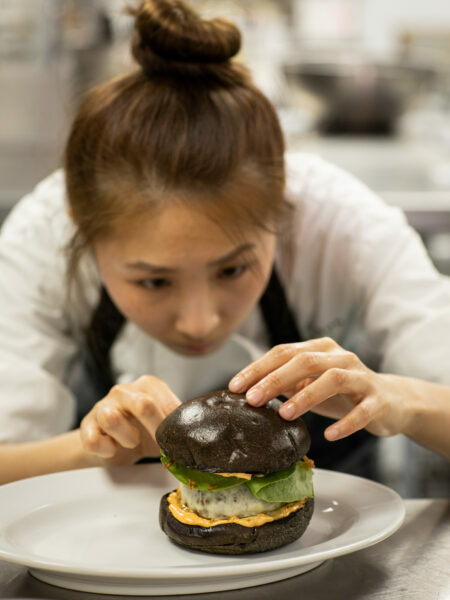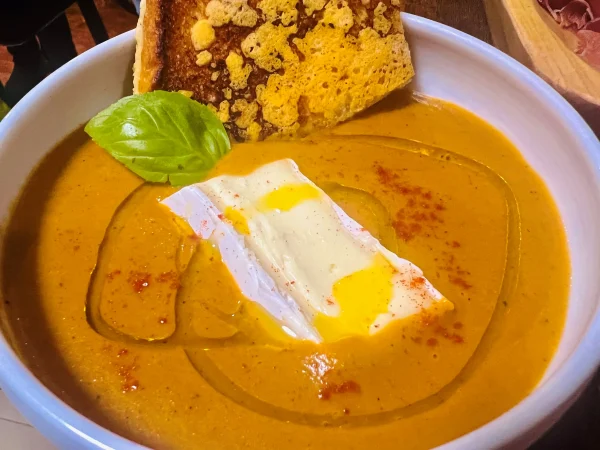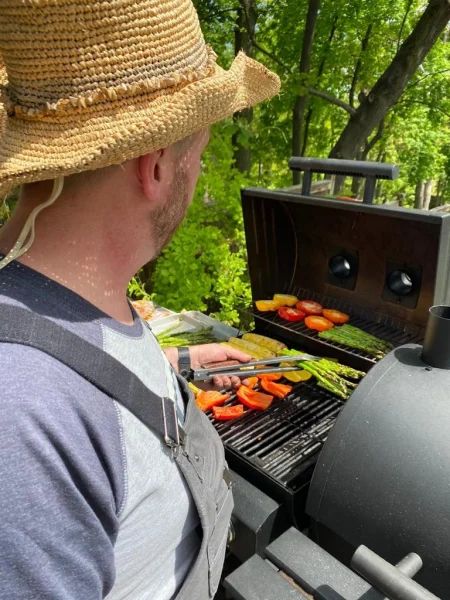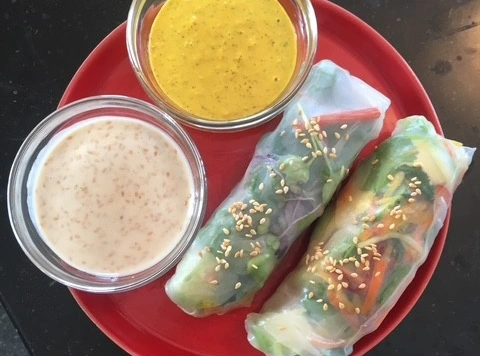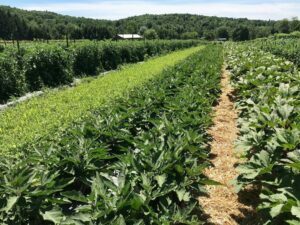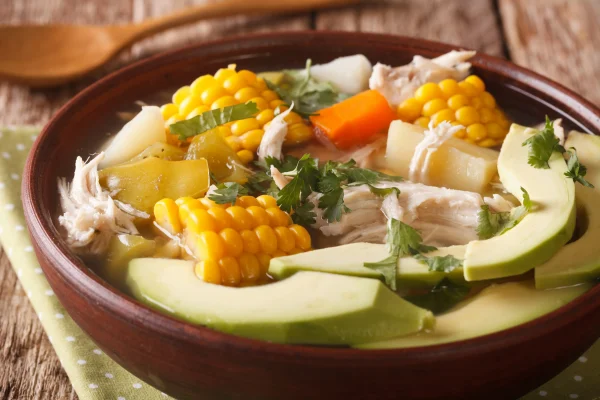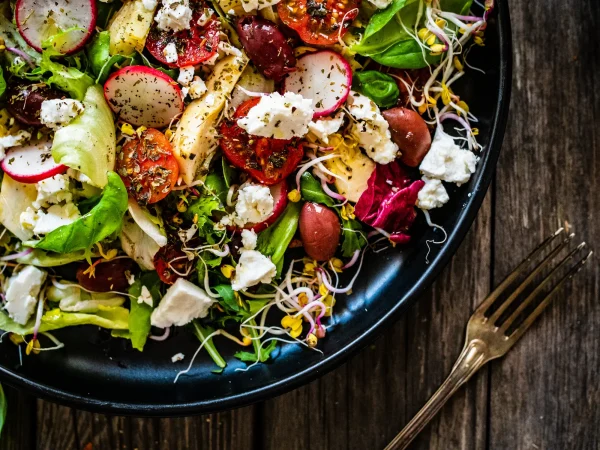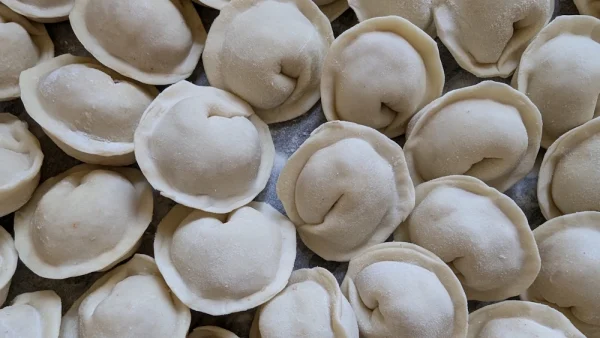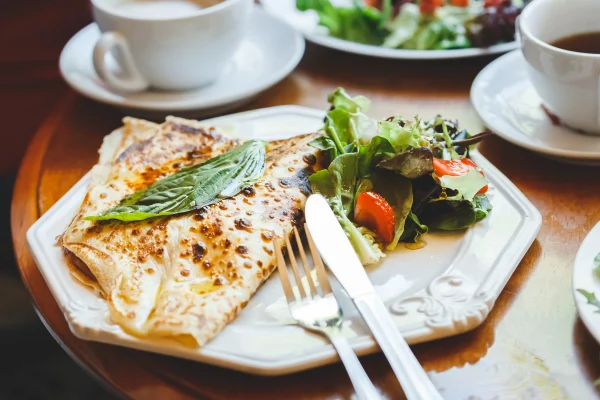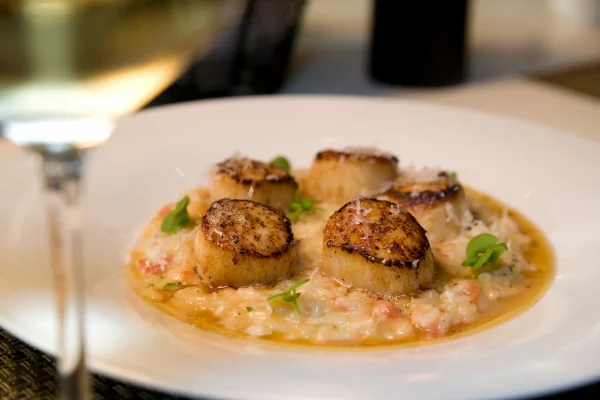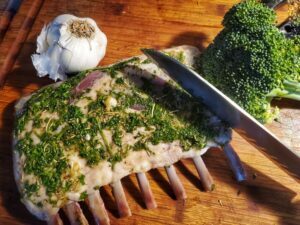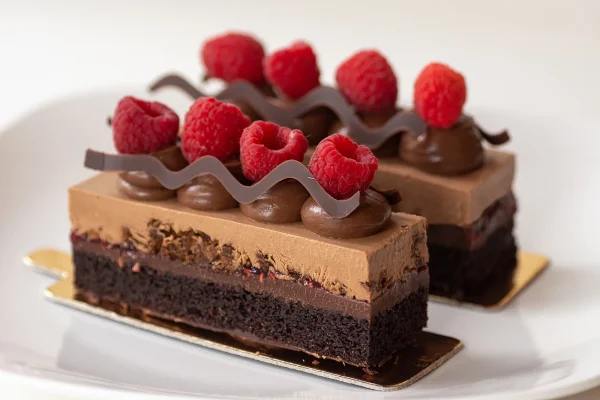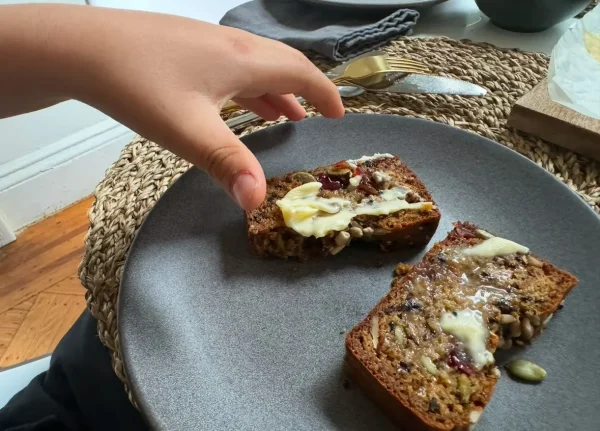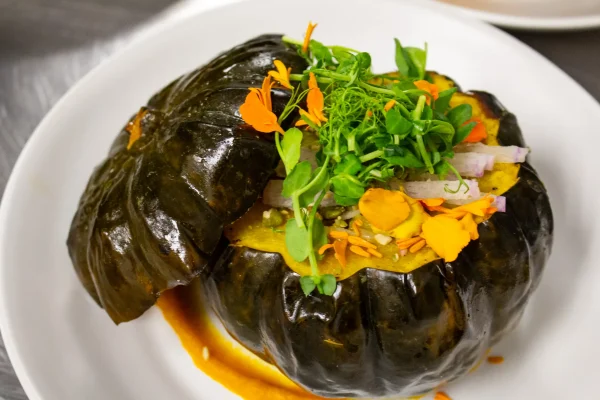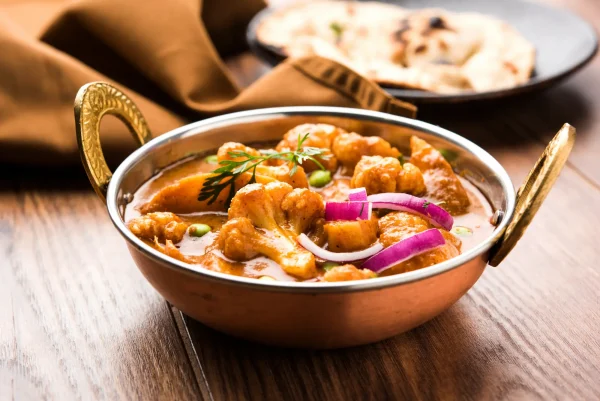
SUPPORTING EMERGING CHEFS: WORKING WITH JAMES BEARD FOUNDATION FELLOWS
By Georgette Farkas
If you’ve had the privilege of attending the James Beard Foundation Awards, you’re familiar with their reputation as the “Oscars” of the culinary world. Yet the Foundation’s mission has evolved well beyond hosting the glamorous annual gala. Today JBF works to support and elevate the people behind America’s food culture, championing a standard of good food anchored in talent, equity, and sustainability. Like the James Beard Foundation, Great Performances appreciates the value of a glittering event, but is equally engaged in nurturing the culinary community. We have worked with the JBF for years, and since the spring of 2021, we have partnered with their new Fellows Program, providing professional development for emerging chefs. The program recruits candidates through the Food Education Fund, a New York City based non-profit enriching the lives and education of culinary focused public high school students and alumni. They are drawn from communities often underrepresented among America’s chefs. The program complements their culinary know how with essential training in finance, small business management, legal advice, wine knowledge, media training and personal brand development.
The Great Performances culinary team mentors the JBF Fellows in creating their Beard Boxes, the final challenge they face in completing the program. This is a dinner menu kit shipped to JBF supporters across America. We guide each fellow in adapting their menu to the rigors of a professional kitchen, working with them in selecting seasonal ingredients, scaling their recipes, and finally preparing and packaging their food. It has been an inspiration to support these highly motivated young professionals. We find we learn as much from them as they do from us. It is our pleasure to share some of their stories with you.
We would like to acknowledge CAPITAL ONE as the presenting Sponsor of the James Beard House Fellows Program.
JANUARY FOOD FESTIVAL: TURNIPS
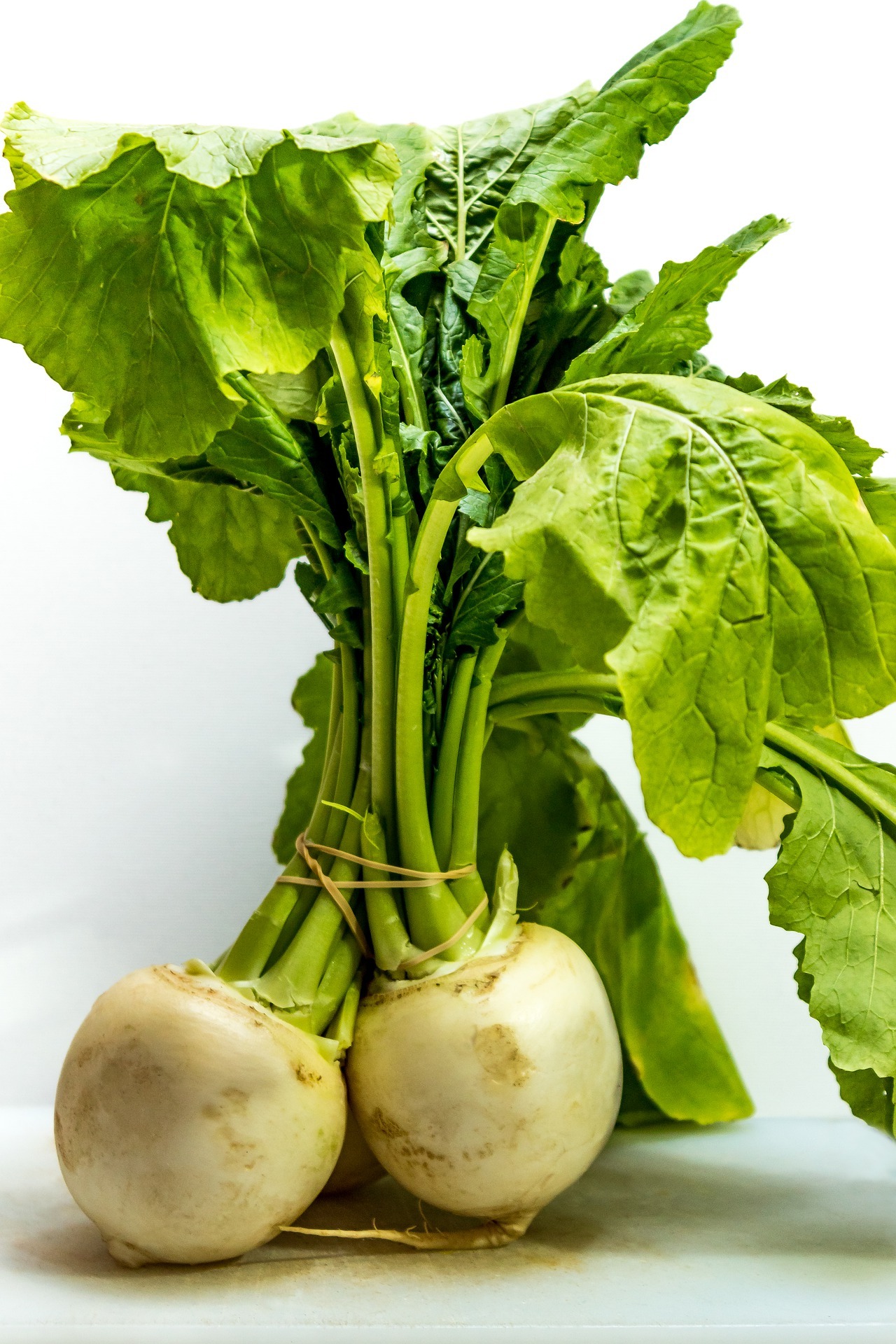
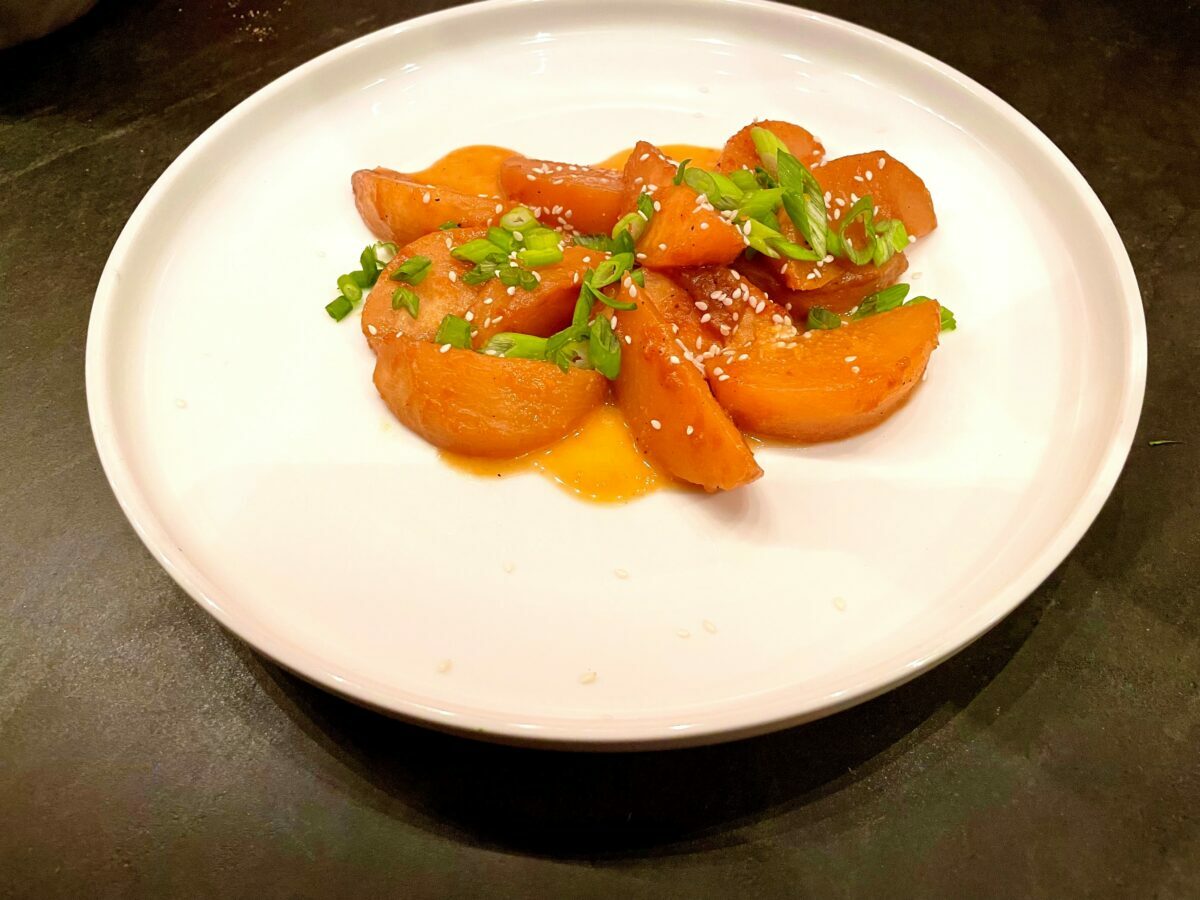
EMBRACE TIP:
Turnips are a hearty root vegetable for carbohydrate-conscious eaters. 1 cup of turnips contains about 8 grams of carbohydrates.
Looking for more health supportive and wellness content? Check out GP Embrace
Each month, our Great Performances menus feature seasonal ingredients. It’s our way of celebrating the earth and bringing our special touch to every menu.
Turnips are a root vegetable in the mustard family, related to radishes and arugula. Pliny the Elder in the first century BCE regarded turnips as the most important vegetables of his time. Over the course of two millenia, turnips have become a prized crop to an often overlooked vegetable. But we think you should take a closer look at the turnip.
Occasionally bitter, this can be countered by peeling the turnip past the yellow line. Turnips can be eaten raw, pickled, preserved, mashed, roasted, and pureed. Low in calories and rich in fiber, they’re a great source of vitamin C and contain vitamins B6 and K and trace minerals. The greens are also edible and are a powerhouse of nutrients including vitamins A, C, K, calcium, folic acid, and magnesium.
Georgette Farkas, our culinary ambassador created a delicious turnip dish for us.
ORANGE-MISO GLAZED TURNIPS
Classic glazed vegetables call for only a little butter, a drop of sugar and water. Make this recipe your own by varying the seasoning. The timing is flexible and forgiving. It will depend on the heat of your stove, the type and size of saucepan you use, the thickness of the vegetable cut and the amount of liquid added. Cook the turnips until they are translucent and easily pierced with a knife point. Serve with jasmine or forbidden rice or as a side dish to accompany roasted poultry or meat.
Ingredients
- 4 medium turnips, peeled and cut in wedges, approx. 2 cups or 6 oz
- 3 whole scallions, white section cut in one inch pieces, green tops thinly sliced
- 1 tbs butter
- 1 tbs white miso
- 1 whole orange, zested and juiced
- 1 tsp honey
- ¼ tsp ground ginger
- Ground black pepper
- 1 cup water
- 1 tsp sesame seeds, lightly toasted
Procedure
In a heavy bottomed saucepan over low heat, melt butter and whisk in miso, orange juice and zest, honey, ginger and black pepper. Toss in the turnips and the white part of the scallions. Add just enough water to cover. Bring to a simmer and cook uncovered, tossing from time to time, approximately 20 minutes. The liquid will be reduced and form a syrupy glaze coating the vegetables. Add more water from time to time, as needed, if the glaze thickens before the vegetables are fully cooked. Transfer to a warm serving plate and top with sesame seeds and scallions.
Katchkie Farm in Kinderhook, NY is dear to our hearts, not only because that is our local, organic farm; but because it allows us to educate children on food and where it comes from via the Sylvia Center. Katchkie Farm has recently become one of our wedding venues.
At Great Performances, food is woven into every moment from a quick coffee break to a grand celebratory feast. We bring this belief to life through delicious food, warm hospitality, and boundless culinary creativity. At the heart of it all is our Chefs’ Choir℠ ensemble – a unique and diverse group of extraordinary chefs and cooks who power our catering, café, and restaurant services. With their diverse talents, perspectives, and culinary expertise, they shape the unforgettable menus that define our events, from corporate gatherings and nonprofit galas to weddings and milestone celebrations; and that feed our diners at our cafés and restaurants.
Through the Chefs’ Choir℠ ensemble, our chefs step beyond the kitchen to share their passion and expertise directly with you. They offer recipes to try at home, stories that inspire, insights into their craft, and tips to elevate your cooking. Whether you’re looking to recreate a signature dish, explore new techniques, or simply find fresh inspiration, the Chefs’ Choir℠ ensemble brings the artistry and creativity of Great Performances into your home, making every meal a celebration.
MORE THAN JUST JAZZ - INCREDIBLE EVENTS AT JAZZ AT LINCOLN CENTER
By Great Performances
At Great Performances, we have the pleasure of working with some of the most iconic venues and cultural institutions in New York City, including Jazz at Lincoln Center. Our event team works tirelessly on every event, ensuring that the menus will tempt the guests, that the food is beautiful and delicious, and the service is impeccable. And at no venue are we more thrilled to see things come to life than at Jazz. The past few months have been especially notable for the variety of events we’ve held there.
Jazz at Lincoln Center is one of the most versatile, dynamic venue for events. This multi-faceted space includes stunning views of Columbus Circle and Central Park South, state of the art audio visual technology, and flexible rooms which allow for a variety of configurations. It’s the perfect venue for conferences, gala, film premiers, concerts, and weddings. Events become experiences at Jazz at Lincoln Center.
The elegance and beauty of Jazz at Lincoln Center, particularly the three-story windows in the Appel Room that offer spectacular views of New York City, make Jazz a stunning setting for awards ceremonies and tribute events.
Highly configurable rooms make Jazz at Lincoln Center a favorite location for some of the top corporate events and conferences. From a hybrid dinner and performances in the Appel Room, to a fall-themed annual investor conference and a corporate 25th Anniversary Gala, we’ve hosted Fortune 500 companies, C-level executives, and high-profile industry leaders at Jazz.
Film premieres find the perfect stage in The Rose Theater at Jazz at Lincoln Center which boasts the ATMOS® Cinema System. 108 speakers create a state-of-the-art surround sound cinematic experience that ensures every nuance of a film is heard. Configurable seating options help to create the perfect experience for audiences. Some notable premiers from the past year include The Last Duel starring Ben Affleck, Matt Damon and Jodie Comer; National Geographic’s anthology series The Hot Zone; Steven Spielberg’s adaptation of West Side Story; Stillwater with Matt Damon; House of Gucci with Lady Gaga, Jared Leto and Adam Driver; Don’t Look Up with Jennifer Lawrence, Leonardo DiCaprio, Meryl Streep; and Being the Ricardos with Nicole Kidman and Javier Bardem.
Nonprofit organizations have long held events at Jazz at Lincoln Center, including UNICEF’s 75th anniversary held on Giving Tuesday this year. The configurable tiered seating in the Appel Room lends itself well to dinners during a presentation as it gives everyone an excellent view of the speakers; while the Ertegun Atrium’s large floor plan, and floor-to-ceiling windows provide bright, natural light during the day and dramatic views of New York City during the evenings.
Jazz at Lincoln Center is an incredibly special venue for weddings. Music buffs and Jazz lovers will appreciate the space and its history. And of course, when looking for elegant spaces, incredible views, and a variety of spaces to have a reception, a seated dinner, dancing, and an after party, Jazz at Lincoln Center is perfect for weddings.
Check out some of the photos from our events in our galleries below!
AWARDS CEREMONIES AT JAZZ AT LINCOLN CENTER
2021 Heisman Trophy Ceremony on ESPN
After touring dozens of venues across New York City, the Heisman Trust and ESPN leaders selected the stunning Appel Room for the Heisman Trophy Ceremony held Saturday, December 11, 2021. Production design was done by award-winning creative director David Korins with lighting design by David Grill and a 9-foot tall hand-carved and painted replica Heisman trophy by Rebecca Ward of Mystic Scenic Studios.
Heisman Trophy Ceremony Menu
BUTLERED HORS D’OEUVRES
Chicken & Waffle, maple butter and syrup, crispy kale; Lobster Roll, toasted brioche, chives; Habanero Lime Fish Taco, crispy corn tortilla; Thick Cut Smoked Bacon Bao Bun, heirloom tomato, kimchi, sriracha aioli; BBQ Short Rib, roasted poblano, stone ground grits; Boneless Lamb Chop, mint chimichurri, pretzel brochette; Roasted Cherry Tomato Tatin, savory onion jam; Truffled Mushroom and Fontina Pizzetta; Cheeseburger Slider, cheese, thin butter pickles, ketchup, mustard.
CORPORATE EVENTS AND CONFERENCES AT JAZZ AT LINCOLN CENTER
Annual Investor Conference
Bright, open spaces and easily configurable seating make Jazz at Lincoln Center an easy choice for corporate events, easily accommodating a 200-person annual investor conference. Spectacular views of New York City and Columbus Circle provided the backdrop in the Appel Room for the seated dinner that capped the event.
Annual Investor Conference Break Menu
Truffle & Herb Popcorn; GP Signature Nori Crunch Mix, plantain chips, wasabi green peas, corn nuts, roasted chickpeas, nori, smoked paprika; Root Vegetable Chips, yucca, beet, golden potato
Annual Investor Conference Dinner Menu
FIRST COURSE
Roasted Winter Squash Trio & Burrata, brussels sprouts, apple, endive, pumpkin seeds, rye crisp
ENTRÉE
Duo of Filet Mignon & Branzino, roasted cauliflower, almonds, baby leeks, fingerling potatoes, romesco sauce, bordelaise sauce; Vegan Torta Panzanella, roasted, smoked and marinated vegetables, herbed polenta, balsamic glaze, basil oil
MINI SWEETS FOR THE TABLE
Golden Apple Dome, vanilla apple compote, caramel mousse, caramel glaze; Key Lime Tartlet; Cookies & Cream Cone; Turtle Brownie
AFTER PARTY PASSED SWEETS
Lemon Meringue Pie Pop; Raspberry Ganache Cup, red berries, raspberry balsamic ganache, dark chocolate cup; Warm Chocolate Chip Cookie & Vanilla Milkshake; Assorted Truffles
AFTER PARTY CREPE STATION
Crepe Station, chocolate creme crepe cake, vanilla creme crepe cake, chocolate sauce, matcha sauce, mango sauce, raspberry sauce
Corporate Anniversary Dinner and Performance
The Appel Room boasts a stage that can be configured to accommodate a seated dinner while a performance takes place on the stage below, all with dazzling views of New York City and Central Park South in the background. This provided the perfect setting for a 150-person corporate anniversary event.
Corporate Anniversary Dinner Menu
FIRST COURSE
Kabocha Squash & Apple Tart, whipped goat cheese, gotham greens, cider vinaigrette; Salanova Greens & Blossoms, carrot-elderflower emulsion, lemon vinaigrette, toasted sunflower seeds
ENTRÉES
Grilled Prime Beef Entrecote, truffled potato gratin, gruyere creamed spinach, bordelaise sauce; Wild Rice Crusted King Salmon, arugula pesto, dill butter braised red beet, radish, turnip; Vegan Torta Panzanella, roasted, smoked and marinated vegetables, herbed polenta, balsamic glaze, basil oil
DESSERT
Chocolate Blackout, chocolate crémeux; malted milk chocolate custard, devil’s food cake, blackout chocolate glaze, chocolate pretzel crunch, sugar beet gel
FILM AND MOVIE PREMIERES AT JAZZ AT LINCOLN CENTER
Film and Movie Premieres
The Rose Theater boasts the ATMOS® Cinema System featuring 108 speakers that create a state-of-the-art surround sound cinematic experience. Adjacent to the Ertegun Atrium, the perfect space for a red carpet, and plenty of space for a cocktail reception, after party, and more, Jazz at Lincoln Center has been beloved by production companies for decades. This year, we’ve been delighted to host many premieres including Being the Ricardos, Hot Zone, House of Gucci, Last Duet, Stillwater, and West Side Story.
Sample Cocktail Reception Menus – 1
Classic Arancini; Truffled Mushroom Pizzetta, frisee, fontina, lemon; Spicy Thai Chicken, baby gem lettuce cup; Pink Snapper Ceviche Taco, charred celeriac taco shell, jalapeño, green olive, micro radish; Lobster Roll, toasted brioche, chives; Food Hall Beef Burger, onion jam, fontina; Cuban Sandwich, roasted pork, swiss cheese; Pulled Chicken, green chili, polenta cake
Mocha Brownie Bites, coffee whipped ganache; Blackberry Cheesecake
Sample Cocktail Reception Menus – 2
Hot & Spicy Chicken Meatball, thunder pickle remoulade; Spaghetti & Meatball, fra diavolo sauce; Smoked Salmon Napoleon, horseradish cream, dill; Rare Seared Tuna, hawaiian black sea salt, apple celery root remoulade, gaufrette; Coconut Shrimp, apricot mustard; Thick Cut Smoked Bacon Bao Bun, heirloom tomato, kimchi, sriracha aioli; Habanero Smoked Tofu Taco, watermelon radish wrap; Hudson Valley Succotash Tart, sunchoke puree, crispy kale
Sample Cocktail Reception Menus – 3
Hot & Spicy Chicken Meatball, thunder pickle remoulade; Burger Slider, onion jam, fontina; BBQ Short Rib, roasted poblano, stone ground grits; Smoked Salmon Napoleon, horseradish cream, dill; Rare Seared Tuna, hawaiian black sea salt, apple celery root remoulade, gaufrette; Coconut Shrimp, apricot mustard; Habanero Smoked Tofu Taco, watermelon radish wrap; Truffled Mushroom & Fontina Pizzetta; Crispy Mac & Cheese Bite
NONPROFIT EVENTS AND GALAS AT JAZZ AT LINCOLN CENTER
Unicef 75th Anniversary Gala Dinner
Jazz at Lincoln Center has hosted dozens of nonprofit events over the years. Unicef’s 75th Anniversary Gala Dinner included speakers, performances, and videos, all of which were integrated seamless into the event. Dozens of opportunities for custom branding include light projections, custom seatback covers, and chocolate disks bearing the Unicef logo.
BUTLERED HORS D’OEUVRES
Spaghetti & Meatball, fra diavolo sauce; Boneless Lamb Chop, mint chimichurri, pretzel brochette; Lobster Roll, toasted brioche, chives; Rare Seared Tuna, hawaiian black sea salt, apple celery root remoulade, gaufrette; Butternut Squash & Fig Tartlet, goat cheese, toasted pistachio; Habanero Smoked Tofu Taco, watermelon radish wrap;
Nonprofit Gala Menu
APPETIZER
Roasted Winter Squash Trio & Burrata, brussels sprouts, apple, endive, pumpkin seeds, rye crisp
ENTRÉE
Filet Mignon Bordelaise, spinach rosti, red beet soubise
MINI DESSERTS
Chocolate Dipped Cheesecake Lollipops, blue sprinkles; Fruit Tartlet; Lemon Meringue Pie Pop; Mocha Brownie Bites, coffee whipped ganache; Raspberry Ganache Cup, red berries, raspberry balsamic ganache, dark chocolate cup; UNICEF Logo Chocolate Disk
WEDDINGS AT JAZZ AT LINCOLN CENTER
Romantic Weddings
We don’t often host weddings at Jazz at Lincoln Center, but when we do, you know it’ll be spectacular. From the dazzling backdrop of New York City and Central Park South visible through the floor-to-ceiling windows in both the Ertegun Atrium and the Appel Room, to dramatic lighting and stunning florals, the 200-plus guests were captivated by the views. Add in delectable food from cocktial reception through after party, and you’ve got an event that people will remember for years to come.
Wedding Menu
COCKTAIL RECEPTION – BUTLERED HORS D’OEUVRES
Mini Peking Duck Rolls, crepe, scallion, celery, hoisin sauce; Seared Foie Gras, lingonberry jam, brioche toast; Lobster Roll, buttered brioche, chives, gold foil; Bloody Mary Shrimp Cocktail; Wild Mushroom Beggar’s Purse; Beef Filet, balsamic onion jam, horseradish cream, ficelle crostini, chive; Spaghetti & Meatball, fra diavolo sauce; Potato Latkes, smoked salmon rosette, crème fraiche, dill; Maryland Crab Cake, shaved fennel, orange and radish slaw; Edamame Truffle Dumplings, miso broth
COCKTAIL RECEPTION STATIONS
Oyster Station; Sushi Station
FIRST COURSE
Poached Lobster, cauliflower sprouts, carrots, caviar, watercress, blood orange vinaigrette; Burrata, butternut squash puree, spice pickled grapes, chervil, pink peppercorn
ENTRÉES
Herbed Double Lamb Chop, haricot verts, truffled mashed potatoes, red wine sauce, mint sauce; Sea Bass, tomato confit, spinach, turnips, carrots, coconut green onion jasmine rice, saffron beurre blanc sauce; Eggplant Chermoula, roasted cherry tomato, harissa, tahini, herbed cauliflower couscous, crispy chickpeas
DESSERT
Individual Wedding Cakes
Cinnamon Churros, dulce de leche sauce; Garnished Hot Apple Cider; Mini Apple Cider Doughnuts; Lemon Meringue Pie Pop; S’mores Cone; Warm Chocolate Chip Cookie & Vanilla Bourbon Milkshake Shot; Espresso Martini Shot
AFTER PARTY
Pizza; Grilled Cheese; Waffles; Ice Cream
Contact Us to Start Planning Your Event at Jazz at Lincoln Center
CHEFS' CHOIR(sm) Holiday 2021 Edition
At Great Performances, food is woven into every moment from a quick coffee break to a grand celebratory feast. We bring this belief to life through delicious food, warm hospitality, and boundless culinary creativity. At the heart of it all is our Chefs’ Choir℠ ensemble – a unique and diverse group of extraordinary chefs and cooks who power our catering, café, and restaurant services. With their diverse talents, perspectives, and culinary expertise, they shape the unforgettable menus that define our events, from corporate gatherings and nonprofit galas to weddings and milestone celebrations; and that feed our diners at our cafés and restaurants.
Through the Chefs’ Choir℠ ensemble, our chefs step beyond the kitchen to share their passion and expertise directly with you. They offer recipes to try at home, stories that inspire, insights into their craft, and tips to elevate your cooking. Whether you’re looking to recreate a signature dish, explore new techniques, or simply find fresh inspiration, the Chefs’ Choir℠ ensemble brings the artistry and creativity of Great Performances into your home, making every meal a celebration.
For our 2021 holiday card, we invited our chefs to share their voices with us. This video captures their passion for memorable holiday dishes and cooking. They sing to us, our culinary choir! Their inspiration, recipes, are included below!
Georgette Farkas - Culinary Ambassador
Tarte TatinIn my childhood I recall my father would judge a French bistro by the quality of its tarte tatin. Years later while filming a TV cooking series on location in France, I happened to visit the Loire Valley Hotel in Lamotte Beuvron where the tarte is said to have originated. It ahs since become my favorite fall and winter season dessert. This is rustic French comfort food in the form of a tart baked upside down and then inverted just before serving. It is essential to bake the tart until the apples are deeply caramelized and ready to melt in your mouth, yet still hold their shape. Honey crisp apples are the best, but Galas will do in a pinch. I bake my Tatin in a cast iron skillet, but just about any oven proof baking dish will do. Pâte Brisée makes for the ideal crust. Serve the tarte warm. Crème fraîche on the side is a non-negotiable must. Ingredients
Fully baked tart can be held un-inverted in its skillet until just before serving. If you have made the tart ahead, be sure to warm it before serving. Pâte Brisée (pastry crust) Ingredients
Procedure
Caramel Sauce Ingredients
Procedure In a high sided saucepan over medium heat, cook sugar and water until they reach a deep caramel color. Deglaze with cream. Add ½ teaspoon salt. Spread caramel sauce over the tart just before serving. Chef Georgette’s Tips:
|
Rodrigo Cando - Sous Chef
Butternut Squash Stuffing
Roast the butternut squash till just cooked and toast the bread until golden. Combine all ingredients and add chicken stock, mixing till just combined (do not overmix). Bake in oven for 30-35 minutes till heated through and the egg is cooked (internal temperature of 165°F). |
Chris Harkness - Vice President of Food and Beverage
Pan Seared Scallops with Blood Orange and Radish SaladI made this dish for my daughter in the early 2000s. I always tried to make different dishes each year, but this one was on her list of cannot change. Scallops
Season the scallops with salt and pepper. Add the scallops to the pan, cook until there is a good even caramelization on one side, turn over the scallops in the pan and turn off the flame. Radish Salad
Arrange the Oranges on a platter, slice the radish in rounds and place on top of the oranges, sprinkle a generous amount of the remaining ingredients and serve with the seared scallops. Chef Chris’ Tips: Leaving the oranges out of the refrigerator so they are not cold is key!! |
Mike Deuel - Executive Chef of Catering Operations
Herring Under Fur Coat
- 2 medium beets
- 2 medium Yukon Gold potatoes, peeled
- 2 medium carrots, peeled and halved crosswise
- 2 large hard-boiled eggs
- 1 cup finely chopped pickled herring
- ¼ cup minced sweet onion
- ¼ cup canola oil
- 2 tablespoons chopped dill, plus sprigs for garnish
- ½ cup mayonnaise
- Kosher salt
Directions
- Preheat the oven to 450°. Wrap the beets in foil and roast for about 1 hour, until tender. Let cool slightly, then peel.
- Meanwhile, in a saucepan, cover the potatoes and carrots with at least 2 inches of water and boil until tender, about 15 minutes for the carrots and 20 minutes for the potatoes. Let cool to room temperature. Grate the potatoes on the medium holes of a box grater and transfer to a small bowl. Repeat with the carrots and beets, keeping the vegetables in separate bowls.
- Halve the eggs. Push the egg whites through a fine sieve into a small bowl. Clean the sieve, then push the yolks through into another small bowl.
- In another bowl, mix the herring with the onion, oil and chopped dill.
- In a small bowl, mix the mayonnaise with 2 tablespoons of the grated beets.
- Place a 4-inch round ring mold in the center of a serving plate. Using the back of a spoon, spread one-fourth of the grated potatoes inside the mold in an even layer. Season with salt. Spread one-fourth of the herring mixture on top in an even layer. Repeat the layering with one-fourth each of the carrots and beets. Season with salt. Spread 2 tablespoons of the beet mayonnaise on top. Garnish with some of the sieved egg whites, sieved egg yolks and dill sprigs. Carefully remove the ring mold and wipe it clean. Repeat to form 3 more molded salads.
Chef Mike’s Tips:
The cooked vegetables can be refrigerated overnight.
Joe Bachman - Venue Chef, Wollman Rink
Butternut & Goat Cheese Gratin with Toasted Pecans
Growing up my mother would always make the traditional holiday sides like green beans, sweet potato and marshmallow casserole and my father would always handle the meat side of the dinner, usually baked lobster tail and chorizo and corn bread clam stuffing. They were never very adventurous eaters and would repeat the same exact meal year after year. After I started my cooking career and develop my cooking knowledge and palette I slowly started to introduce new things into their arsenal. This dish I made years ago when I was still in culinary school for the Holidays as an attempt to get my mother to try goat cheese. It was a hit and now she makes it herself every holiday.
Ingredients
- 3 butternut squash
- 2 sweet potatoes
- ¼ lb butter, small dice
- 2 c whole milk
- ½ tsp cayenne pepper
- 1 ½ c pecan halves
- 2 tsp espelette peppers
- ½ c chives, sliced
- 1 c crumbled goat cheese
Procedure
- Cut butternut Squash in half, scoop out seeds and place flesh side down on an oiled Sheet pan and place in a 350 degree oven for 25 min or until they can be easily pierced with a knife.
- Salt sweet potatoes and place in 350 degree oven with skin on and roast whole until soft enough to easily pierce with a knife.
- While the squash is cooking heat the milk in a pan then then set aside.
- Once the butternut and sweet potato are done cooking. Remove from the oven and scoop out the flesh from the skins of both into a bowl then add the cayenne, 1/4 C. of goat cheese, milk , and butter and whip with a whisk until smooth. Season with salt to taste, then transfer the mixture to a pan or cast iron skillet to bake.
- Top the mixture with the remaining crumbled goat cheese, pecans and espelette pepper then place in an oven to bake at 375 degrees until pecans are toasted and top starts to brown. Approximately 12-15 minutes.
- Sprinkle the cut chives and enjoy!!!
Chef Joe’s Tips:
- When whipping the mixture , a Kitchen Aide works best but a simple whisk will also work.
- Small dice the cold butter and add in batches while whisking for best texture.
- Be careful not to cook the topping too long as the goat cheese will dry out.
Tatiana Iglesias - Venue Chef
Turkey Porchetta
8 Servings
Ingredients
- 1 teaspoon fennel seeds
- ½ teaspoon crushed red pepper flakes
- 1 tablespoon kosher salt
- 2 tablespoons olive oil
- 2 ounces pancetta (Italian bacon), chopped
- 4 garlic cloves
- 3 sage leaves
- ½ cup parsley leaves
- ¼ cup coarsely chopped fresh chives
- 1 teaspoon finely chopped fresh rosemary
- 2 teaspoons finely grated lemon zest
- 1 whole skin-on, bone-in turkey breast, bones removed
- 12 slices bacon
Special Equipment
- A spice mill or a mortar and pestle
Procedure
- Grind fennel seeds and red pepper flakes in a spice mill or with a mortar and pestle until very fine. Toss spice mixture and salt in a small bowl; set aside.
- Heat oil in a small skillet over medium. Cook pancetta, stirring often, until brown and crisp, 5-8 minutes. Let cool. Transfer pancetta and fat in skillet to a food processor, add garlic, and process to a smooth paste. Add sage, parsley, chives, rosemary, and lemon zest and process until smooth; set paste aside.
- Pat turkey breast dry and place skin side down on a large rimmed baking sheet so thickest part of breast is closest to you. Run your fingers underneath fillets lengthwise to detach. Next, you’re going to butterfly each side of the breast so that the meat is of uniform thickness. Starting on one side and using a thin, sharp blade, position knife about 3″ from neck end (the widest part of the breast) and cut downward into the thickest part of the flesh at a 45° (do not cut all the way through. Open top flap you’ve just created like a book. Fold the fillets you removed at the beginning in half and place in the top and bottom V-shaped gaps between the breasts. The idea is to create a layer of meat of uniform thickness across the entire breast.
- Sprinkle reserved spice mixture all over turkey flesh; rub into crevices. Rub paste all over flesh of turkey to coat evenly, working into crevices. Roll up turkey breast like a jelly roll to form a log; position seam side down and tuck skin under at each end. Loop a length of string around outside edge and tie closed. Starting at center, tie with kitchen twine at even intervals (apply some pressure with string so turkey holds a nice round shape, but don’t tie too tightly or it will bulge when cooked).
- Let rolled turkey sit 2 hours to bring to room temperature.
- Preheat oven to 325°. Roast turkey on baking sheet until skin is golden and starting to crisp, 40-45 minutes. Remove from oven and carefully remove strings with kitchen shears. Drape with bacon slices, overlapping; tuck ends underneath turkey to secure. Roast until an instant-read thermometer inserted into the thickest part registers 140°, 30-40 minutes.
- Increase oven temperature to 400° and cook until bacon is browned and crisp and thermometer registers 150°, 5-10 minutes longer. Transfer to a platter and let rest at least 40 minutes before slicing. Serve with pan juices.
Chef Tatiana’s Tips:
Do Ahead: Turkey breast can be rolled 1 day ahead. Chill uncovered on a rimmed baking sheet.
Frank McConnell - Sous Chef, Rockefeller University
Crown Roast of Pork
Ingredients
- 1 8 to 9 pound crown roast of pork (14 to 22 ribs depending on how meaty the ribs) frenched and prepped by butter
- 1 tablespoon chopped fresh thyme
- 1 tablespoon chopped fresh sage
- 2 teaspoons kosher salt
- 1/4 teaspoon freshly ground black pepper
- 1 cup water
Procedure
- Preheat the oven to 350 degrees
- Roast the pork at 350 degrees on the middle rack of oven for 2 to 2 1/2 hours
Andrew Smith - Culinary Director
Stuffed Kabocha Squash Salad
Instructions
Pre heat oven to 300 degrees. Cut top of kabocha squash 2.5 inches from the top. Scrape out seeds with a spoon till interior is clean. Season inside squash with salt, olive oil, and whole leaf sage and thyme place on sheet tray. Split spaghetti squash in half length wise. Remove seeds with a spoon the same way as the kabocha squash, season with salt, sage and thyme. Place onto the same sheet as kabocha. Cover whole tray with aluminum foil to prevent squashes from taking on color while cooking. Place into 300-degree oven and cook for 45 minutes to an hour. Check both squashes with the tip of knife to make sure they are cooked through. Remove from oven and set aside to cool. Using a fork rake the spaghetti to separate the flesh from the skin then set aside. slice apples thin and cut into matchsticks. Mix together spaghetti squash, apples, feta cheese, EVOO, lemon juice. Stuff salad inside kabocha and garnish with pumpkin seeds
Richard Brown - Executive Chef, The Plaza Hotel
Rutabaga Sauerkraut
- 3 rutabagas (2.75 lbs.)
- 3 tsp duck fat
- 2 Spanish onions, brunoise
- 6 oz. cider vinegar
- 32 oz. chicken stock
- Sache of juniper berries, caraway seeds, bay leaves, thyme, parsley stems, and black peppercorns
- 2 Tbsp Kosher salt
- 1 tsp honey
Special Equipment
- 1 mandoline
- I small rondeau with a lid (or a pot)
Procedure
Peel the rutabaga and quarter; use the mandoline to julienne the rutabaga; use the blade guard for your own safety. Heat the duck fat in your Rondeau or pot; when it becomes hot, add your onions and turn the flame to medium, sweat the onions for 10 minutes, and add your julienne of rutabaga and continue cooking for 15 minutes. add 1 T spoon of salt; Deglaze with the cider vinegar and honey; let reduce by half. Add the chicken stock and the sachet; bring to a boil; cover and place in the oven. Cook for approximately 1 hr. and check after 30 minutes to make sure there is still liquid present. Your finished product should have liquid and the rutabaga should be al dente. At this point check for seasoning; let it cool; and store in the fridge. Its better if your able to let the Sauerkraut macerate for a day or two.
Happy Holidays!
Aya Mohamed - Chef de Cuisine
Cranberry Sauce
This was my staple to bring to my aunt’s house for Thanksgiving every year since I was a child. It was my responsibility and I took so much pride as a child that I was allowed to contribute to the elaborate dinner we would have and the tradition stuck. Over the years I would be assigned more side dishes, but I always bring my Cranberry Sauce!
Ingredients
- 1 bag cranberries
- 1 tsp orange zest
- ¼ cup orange juice (or juice of 1 orange)
- 6 oz pears, small dice
- ½ cup sugar
- 1 pinch salt
- 1 tsp fresh ginger
- 1 cinnamon stick
- 2 cloves
Procedure
Place all ingredients in a sauce pot and keep on a low simmer for 1-2 hours, stirring every 20 mins until it’s thick and there’s very little liquid left. Remove ginger, cinnamon, and cloves before serving.
Chef Aya’s Tips
This dish is so versatile and you can add red wine if you’d like to spike it. It’s delicious the next day as spread for your biscuits or on your leftover turkey sandwich.
EXCITING EVENTS AROUND NEW YORK: NOVEMBER 2021
By Great Performances
Explore Great Music, Art and More at Our Partner Venues This Month!
A CONVERSATION WITH SPIKE LEE
Saturday, December 11
Location:
WITH DAVID LEE
LAUNCH OF SPIKE
CO-PRESENTED BY BAM AND GREENLIGHT BOOKSTORE
Join Oscar-winning filmmaker Spike Lee and his brother David Lee at BAM for an expansive conversation celebrating the launch of the acclaimed filmmaker’s book, SPIKE. This lavish visual celebration of his life and career to date features storytelling by Lee and hundreds of never-before-seen photographs by David Lee, Spike’s official on-set photographer, from Brooklyn film sets and beyond. In opening his archives, Lee provided behind‐the‐scenes material from the making of his iconic films, documentaries, TV shows, and music videos. Finally, cinephiles and fans of one of history’s most prominent and influential filmmakers can hold his story in their hands, and in his presence.
Spike Lee is a world-renowned, Academy Award-winning filmmaker, a cultural icon, and one of the most prominent voices on race and racism for more than three decades. His production company, 40 Acres and a Mule Filmworks—based in Fort Greene, Brooklyn, just blocks from BAM—has produced more than 35 films, including his directorial debut She’s Gotta Have It, his seminal masterpiece Do the Right Thing, and more recently, the Oscar-winning BlacKkKlansman. He is a graduate of Morehouse College and New York University’s Tisch School of the Arts, where he is a tenured Professor of Film and Artistic Director. Spike Lee’s provocative features, documentaries, commercials (Air Jordan), and music videos (Prince, Michael Jackson) have made an indelible mark in both cinematic history and in contemporary society.
UN ESTADO DE GRACIA / A STATE OF GRACE
November 30, 2021 – March 13, 2022
Location:BAM Strong, The Rudin Family Gallery
Artists: BEMBONA, Alicia Grullón, Lucia Hierro, Ronny Quevedo, Chelsea Ramírez, Kenny Rivero, xime izquierdo ugaz
Curated for BAM by Larry Ossei-Mensah, Guest Curator-at-Large
“Un Estado de Gracia / A State of Grace” presenta a siete artistas latinxs y sudamericanos con sede en Nueva York que utilizan sus prácticas como un foro para reflexionar sobre las nociones de hogar, comunidad, familia (biológica y elegida), memoria, consumismo y complejidad de la identidad. Los artistas emplean diversos medios y formas estéticas, incluida la fotografía, la escultura, la pintura, el dibujo y el sonido para plantear preguntas sobre el desplazamiento, la migración, la memoria y la resiliencia, una resiliencia que ha sido particularmente desafiada en la era de COVID-19, y el viaje. hacia la equidad social.
Artistas: BEMBONA, Alicia Grullón, Lucia Hierro, Ronny Quevedo, Chelsea Ramírez, Kenny Rivero, xime izquierdo ugaz
Photo: xime izquierdo ugaz | Ari with a Sunflower from Themme, The Piers, 2021. Courtesy of the artist.
HOLIDAY MARKET
Sunday December 5, 12, 19 from 11:30 am – 5:30 pm
Location: Martha A. and Robert S. Rubin Pavilion, 1st Floor
Stop by our Holiday Market featuring more than twenty local artisans and vendors offering artwork, jewelry, fashion, home and apothecary goods, and more. Shop one-of-a-kind, handmade items and get into the holiday spirit with performances by carolers and live DJs.
All visitors 12 and older must show proof of vaccination and a valid I.D. Masks are required regardless of vaccination status.
ART HISTORY HAPPY HOUR: WARHOL AND WINE
Thursday, December 16 from 6:00 pm – 7:30 pm and 8:00 pm – 9:30 pm
Location: The Norm Restaurant and Bar, 1st Floor
Expand your knowledge of Andy Warhol’s Pop art with a special after-hours curator talk and a wine tasting featuring selections by Marquis Williams of Highly Recommended, a Brooklyn-based members-only wine club. This month, curator Carmen Hermo pays tribute to our newest exhibition, Andy Warhol: Revelation, focusing on the iconic artist’s less-explored Byzantine Catholic upbringing and the profound impact it had on his artistic practice. Explore the ways that Warhol mixed Pop art and Catholicism, from portraits of celebrities to appropriated Renaissance masterpieces, while you indulge in wine pairings inspired by Warhol’s artistic practice and relationship to his faith. Then, visit the galleries for an exclusive after-hours viewing of Andy Warhol: Revelation.
Tickets are $45 and include four wine tastings, small bites, and special after-hours admission to Andy Warhol: Revelation. Additional wine is available for purchase. Member tickets are $40. Not a Member? Join today!
All visitors must show proof of vaccination and a valid I.D. Masks are required regardless of vaccination status.
NEW YORK POLYPHONY
Saturday, December 11 at 5:00 pm or 7:00 pm
Location: Music Room
Ticket Information: Start at $30
This a cappella vocal quartet brings their exquisitely blended voices back to the Music Room in Sing Thee Nowell, a program of sacred Christmas music spanning seven centuries. Select rooms of the Rosen House, splendidly decorated for the holidays, will be open for viewing one hour prior to each performance. Ring in the holidays with New York Polyphony’s “rich, natural sound that’s larger and more complex than the sum of its parts” (NPR).
MARY STALLINGS AND THE EMMET COHEN TRIO
Thursday December 9 – Sunday December 12, 7:30 pm and 9:30 pm
Location: Dizzy’s Club at Jazz at Lincoln Center
Ticket Information: Starts at $30
“Perhaps the best jazz singer singing today” according to the New York Times, Mary Stallings has performed with the likes of Count Basie, Dizzy Gillespie, Geri Allen, and Harry “Sweets” Edison. On these evenings, she graces the Dizzy’s stage alongside Emmet Cohen’s impeccable trio with a beautiful backdrop of the New York City skyline. This performance will be a true multigenerational showcase, bringing a veteran vocalist together with a trio of young, first-rate instrumentalists.
PERFORMANCE LINEUP
Mary Stallings – Vocals
Emmet Cohen – Piano
Russell Hall – Bass
Kyle Poole – Drums
A VERY IRBY CHRISTMAS
Location: Dizzy’s Club at Jazz at Lincoln Center
Ticket Information: Starts at $35
An accomplished bandleader and a saxophonist with the sweetest tone, Sherman Irby is a longtime member of the Jazz at Lincoln Center Orchestra with Wynton Marsalis. His previous Christmas shows at Dizzy’s left us wanting more, and we’re excited to welcome this warm and swinging show back to the club. A Very Irby Christmas features special guest vocalist, trombonist, and fellow JLCO member Vincent Gardner, pianist Isaiah J. Thompson, bassist Gerald Cannon, and drummer Willie Jones III. Stop by Dizzy’s for some holiday cheer and an unbeatable view of New York City’s winter skyline.
PERFORMANCE LINEUP
Isaiah J. Thompson – piano
Gerald Cannon – bass
Willie Jones III – drums
Vincent Gardner – trombone
Sofija Knezevic – vocals (December 21-22)
Camille Thurman – vocals (December 23-24)
CARLOS HENRIQUEZ NONET
Location: Dizzy’s Club at Jazz at Lincoln Center
Ticket Information: Starts at $40
Carlos Henriquez is the bassist for the Jazz at Lincoln Center Orchestra with Wynton Marsalis and “an emerging master in the Latin jazz idiom” (DownBeat). This week at Dizzy’s, he leads an all-star nonet to close out 2021 with a series of energetic concerts. Hailing from the Bronx, Henriquez is a rare virtuoso in both jazz and Afro-Cuban traditions and a vital voice in the infectious cultural fusion of Latin jazz. He has performed with greats like Tito Puente, Eddie Palmieri, and Celia Cruz since the age of 14. As a JLCO fan favorite and leader of his own small groups, Henriquez regularly headlines concerts in The Appel Room and music directs shows in Rose Theater (including Rubén Blades’s historic performances with the Jazz at Lincoln Center Orchestra). His Dizzy’s engagements are rare, intimate experiences for lovers of Latin rhythms and the swing tradition.
PERFORMANCE LINEUP
Obed Calvaire – drums
Michael Rodriguez – trumpet
Terrell Stafford – trumpet
Melissa Aldana – tenor saxophone
Marshall Gilkes – trombones
Jeremy Bosch – flute and vocals
Anthony Almonte – congas and vocals
HOLIDAY TEA
Thursday, December 23
Tuesday, December 28
Wednesday, December 29
Thursday, December 30
11:45 am and 2:45 pm
Location: The Cafe at Wave Hill
Co-organized by Wave Hill and Lehman College Art Gallery, Eco-Urgency: Now or Never is a two-part exhibition showing the varied responses to our current ecological crisis by artists working across wide-ranging practices. Now, the first part of the exhibition, on view at Wave Hill, brings together artists looking at the urgency of the present moment, raising awareness through a holistic approach to understanding social, political and environmental concerns. Or Never, the second part of the project, to be presented at Lehman College Art Gallery starting December 4, is both speculative and reflective, examining the echoing cycles of history that have shaped and led us to our current moment, alongside possible and causal futures.
Click here to learn moreGreat Performances is delighted to present the Holiday Edition of our Afternoon Tea at Wave Hill. A custom menu designed specifically for Wave Hill, our Holiday Tea uses local and seasonal ingredients and inspiration from our own organic farm, Katchkie Farm.
Delicious tea sandwiches and delectable pastries provide the perfect accompaniment to Tea by Palais des Thés or House Made Hot Cocoa. You can enhance your Holiday Tea with a bottle of sparkling wine.
Start with a selection of Teas by Palais des Thés or enjoy our House Made Hot Cocoa.
You’ll enjoy the comforting decadence of a traditional tea service including
- Tea Sandwiches: Egg and Cress; Smoked Trout and Cucumber; Sliced Apples and Chutney; Griddled Turkey and Brie
- Scones and Cakes: Olive Oil Cake with Candied Citrus; Assorted Scones and Short Bread; Clotted Cream, Raspberry Jam
- Desserts: Raspberry Tartlets; Chocolate Truffles; Dark Chocolate Brownies; Gingerbread Cookies
DECEMBER FOOD FESTIVAL: POTATOES

About the Artist: Erin Robinson is one of our GP Artists. Click here to see more of her art.
EMBRACE TIP:
Potatoes are a good source of potassium, an essential mineral involved in the function of the kidneys, heart, muscles and nervous system.
Looking for more health supportive and wellness content? Check out GP Embrace
Each month, our Great Performances menus feature seasonal ingredients. It’s our way of celebrating the earth and bringing our special touch to every menu.
Potatoes are such an incredibly versatile ingredient and we eat them at almost any time of day. From hash browns in the morning to potato chips with our lunch and mashed potatoes with gravy at dinner or a sweet potato pie for dessert, we love our potatoes.
Chef Mike Deuel spent time training as a chef in Lima, Peru, which continues to influence his cooking today.
CAUSA LIMENA
Before moving to New York, I had the pleasure of training in Lima, Peru. Peru is known for its fresh ceviche, Japanese influence, and its potatoes.
With more than 3,000 varieties of potatoes grown in the country, how could I not share my version of this amazing recipe?
Causa is a simple potato dish that Peruvians treat like sushi rice, forming and topping with a huge variety of ceviche and salads.
Ingredients
- 2 pounds Yukon Gold potatoes, peeled
- 2 Tbsp aji pepper puree
- 1 tsp turmeric
- 1 oz vegetable oil
- Salt and pepper to taste
Procedure
- Cook the potatoes whole in salted water until soft
- Mash the potatoes until smooth, mix in aji puree, turmeric, vegetable oil and season to your liking
- Roll into balls, top with your favorite salad components tomato, avocado, cilantro, red onion
Katchkie Farm in Kinderhook, NY is dear to our hearts, not only because that is our local, organic farm; but because it allows us to educate children on food and where it comes from via the Sylvia Center. Katchkie Farm has recently become one of our wedding venues.
EXCITING EVENTS AROUND NEW YORK: NOVEMBER 2021
By Great Performances
Explore Great Music, Art and More at Our Partner Venues This Month!
AI WEIWEI
November 10
Location:
IN CONVERSATION WITH DEBBIE MILLMAN
CO-PRESENTED BY BAM, GREENLIGHT BOOKSTORE, AND PEN AMERICA
Join world-renowned artist and human rights activist Ai Weiwei on the release date of his highly anticipated memoir, 1000 Years of Joys and Sorrows. While being held by Chinese authorities in 2011, Ai Weiwei decided to write a memoir about his extraordinary life and the legacy of his father Ai Qing, the nation’s most celebrated poet who was banished from society. At once ambitious and intimate, 1000 Years of Joys and Sorrows serves as a timely reminder of the urgent need to protect freedom of expression.
Please note: This event was originally scheduled for Tue, Nov 2 at 7:30pm
REDECODE X CONTAINERS
September 15 – December 15, 2021
Location: Sharp Lower Lobby in the BAM Fisher
Joiri Minaya
Redecode x Containers
Inkjet on vinyl
2021
Redecode x Containers by Joiri Minaya, a New York-based Black Latinx artist, presents portraits from her Containers series (2015–2020) and landscape images from her Redecode wallpaper series. Containers is an ongoing project highlighting female subjects in seemingly natural environments wearing bodysuits Minaya makes using fabric with tropical designs. By abstracting tropical images via pixelation in Redecode, Minaya introduces an unexpected and layered take on cultural tropes historically projected onto Caribbean culture, women, and the region’s natural and commercialized elements. Combining these two series in one pictorial plane, Minaya provides space for the viewer to question imposed histories and ideas, encouraging new and culturally inclusive narratives.
Redecode x Containers is curated by BAM’s Curator-At-Large, Larry Ossei-Mensah.
LAST NIGHT IN SOHO
September 15 – December 15, 2021
Location:
CHRISTIAN DIOR: DESIGNER OF DREAMS
September 10, 2021 – February 20, 2022
Location: Beaux-Arts Court, 3rd Floor
Tickets: $25
The New York premiere of the exhibition Christian Dior: Designer of Dreams traces the groundbreaking history and legacy of the House of Dior. The exhibition brings to life Dior’s many sources of inspiration—from the splendor of flowers and other natural forms to classical and contemporary art.
With objects drawn primarily from the Dior archives, the exhibition includes a vast array of over two hundred haute couture garments as well as photographs, archival videos, sketches, vintage perfume elements, accessories, and works from the Museum’s collection. The haute couture on view exemplifies many of the French couturier’s fabled silhouettes, including the “New Look,” which debuted in 1947.
Presented are galleries devoted to Dior and the artistic directors who succeeded him—Yves Saint Laurent, Marc Bohan, Gianfranco Ferré, John Galliano, Raf Simons, and Maria Grazia Chiuri. A toile room, a tribute to the Ateliers, and adjacent galleries of couture garments showcase the excellence of Dior’s petites mains. The central atrium of our Beaux-Arts Court has been redesigned as an enchanted garden, and a concluding gallery celebrates dresses worn by stars from Grace Kelly to Jennifer Lawrence.
The Brooklyn Museum presentation of Christian Dior: Designer of Dreams is curated by Florence Müller, Avenir Foundation Curator of Textile Art and Fashion, Denver Art Museum, in collaboration with Matthew Yokobosky, Senior Curator of Fashion and Material Culture, Brooklyn Museum.
CALLISTO QUARTET
2021–22 Ernst Stiefel String Quartet-in-Residence
Sunday, November 7 at 3:00 pm
Location: Music Room
Ticket Information: Start at $30
Praised for their “intensity and bravado” (Third Coast Review), the Callisto Quartet’s Ernst Stiefel residency continues this year with two appearances that spotlight emerging composers and the classic works that influenced them. In this performance, you’ll hear a world premiere by Nathaniel Heyder, who was inspired by Brahms’ Third String Quartet, which was itself modeled after the Mozart Quartet also on the program. Above all else, the three works share an unmistakable joy of life and nature.
Artists
Callisto Quartet
Paul Aguilar, violin
Rachel Aguilar, violin
Eva Kennedy, viola
Hannah Moses, cello
Program
Mozart: String Quartet in B-flat Major, K. 458, “Hunt”
Nathaniel Heyder: Vistas (World Premiere)
Brahms: String Quartet No. 3 in B-flat Major, Op. 67
STEPHEN HOUGH, PIANO
Sunday, November 13, 3:00 pm
Location: Caramoor Grounds
Ticket Information: Starts at $30
World-renowned pianist and composer Stephen Hough brings his exceptional artistry to Caramoor for a program that includes the music of Schumann, Chopin, 20th-century British composer Alan Rawsthorne, and Hough himself. Widely regarded as one of the most important and distinctive pianists of his generation, Hough has earned a multitude of prestigious awards and a long-standing international following.
Join us after the concert for a conversation with the artist.
THANKSGIVING WITH WYCLIFFE GORDON
Thursday, November 25, Doors Open 5:30
Location: Dizzy’s Club at Jazz at Lincoln Center
Ticket Information: $178 (Includes cover, food, and gratuity per person. Alcohol not included.)
Wycliffe Gordon, trombone/vocals
Adrian Cunningham, reeds
Ehud Asherie, piano
Yasushi Nakamura, bass
Alvin Atkinson, drums
TWILIGHT: LOS ANGELES, 1992
October 12 – November 14
Location: Irene Diamond Stage
One verdict can change the course of history. The news of the police officers’ acquittal in Rodney King’s police brutality case reverberated throughout the streets of Los Angeles. Variously called a “riot, a revolution, or a social explosion,” the events that followed the verdict drew worldwide attention. Playwright, actor and scholar Anna Deavere Smith responded artistically by dissecting the anatomy of the unrest. She interviewed over 350 Los Angelinos in preparation for the performance. Declared a “rich, panoramic canvas of a national trauma” by The New York Times, Smith’s transformative study of the 1992 L.A. riots reveals the fault lines that set the city ablaze. Twilight: Los Angeles, 1992 is equal parts meticulously researched reportage and stirring cry for reform.
Signature is excited to work with Anna Deavere Smith and director Taibi Magar to reimagine this play for new performers and collaborators.
ECO-URGENCY: NOW OR NEVER
Now through December 5
Location: Glyndor Gallery
Co-organized by Wave Hill and Lehman College Art Gallery, Eco-Urgency: Now or Never is a two-part exhibition showing the varied responses to our current ecological crisis by artists working across wide-ranging practices. Now, the first part of the exhibition, on view at Wave Hill, brings together artists looking at the urgency of the present moment, raising awareness through a holistic approach to understanding social, political and environmental concerns. Or Never, the second part of the project, to be presented at Lehman College Art Gallery starting December 4, is both speculative and reflective, examining the echoing cycles of history that have shaped and led us to our current moment, alongside possible and causal futures.
EARTH IN PERIL: DAVID BENJAMIN PERRY
Now through December 5, 2021
Location: Wave Hill House
With an unrelenting reverence for the natural world, David Benjamin Sherry photographs epic scenes of the American landscape with a particular focus on the West, highlighting its beauty while hinting at its precarious future. Showcasing a selection of color, monochromatic and black-and-white photographs made over the past 12 years, Earth in Peril highlights Sherry’s technical skills, sensitive eye and queer perspective that set his landscape photography apart from his predecessors and contemporaries.
PRISCILLA ALEMAN
Now through December 5, 2021
Location: Glyndor Gallery
Priscilla Aleman’s installation Origins of Devotion transforms the Sunroom into an overgrown, devotional environment that uses the body as an innate symbol in ceremony to convey the sacred, the afterlife and the deities of our time. Referencing traditional sculptures and ancient symbolism, Aleman examines archaeological materials and ecological transformations in the Americas, including the Caribbean, to create sites for ceremony and ritualized performances. Aleman’s sculptural installation will comprise an oceanic exchange of materials collected from the Global South. These will include belongings from family members, replicas of pre-Columbian artifacts and tropical flora from horticultural facilities.
NOVEMBER FOOD FESTIVAL: LEEKS

About the Artist: Erin Robinson is one of our GP Artists. Click here to see more of her art.
EMBRACE TIP:
Leeks contain soluble fiber, which may help reduce cholesterol and blood sugar levels, in addition to supporting better gut health.
Looking for more health supportive and wellness content? Check out GP Embrace
Each month, our Great Performances menus feature seasonal ingredients. It’s our way of celebrating the earth and bringing our special touch to every menu.
Below we share Georgette Farkas’ recipe for leeks – delicious Leeks Vinaigrette. This delightful preparation of leeks really allows the grassy, sweet, onion flavors of leeks to shine through. The leeks are gently poached, then dressed with a red wine vinegar and whole grain mustard vinaigrette before being garnished with crispy bacon, hard boiled eggs, and parsley. Making sure to toss the leeks with the vinaigrette while the leeks are still warm allows the flavors to penetrate and really enhances the dish.
LEEKS VINAIGRETTE
Ingredients
- 8 whole leeks, dark green tops and root end removed
- 1/3 cup red wine vinegar
- 2/3 cup olive oil
- 1 tbs grain mustard
- ¼ cup flat leaf parsley coarsely chopped
- 1 hard boiled egg, shelled, finely chopped
- 1 slice bacon, cooked until crisp, drained, finely chopped
Procedure
- Split leeks along their length and rinse well under running water to remove dirt and sand. Tie leeks in a bundle and poach in well salted water until tender when pierced with point of a knife. Cooking time will vary according to leek’s thickness. Drain well, pressing as needed to remove excess water. Cut leeks into approximately three-inch lengths.
- Prepare vinaigrette while leeks are poaching. Place vinegar, mustard, salt and pepper in a mixing bowl and whisk together until salt is dissolved. Whisk in olive oil. Adjust seasoning to taste. While still warm toss drained leeks in just enough vinaigrette to coat. This enables them to absorb vinaigrette more thoroughly.
- Combine hard boiled egg, bacon and parsley. Season with salt and pepper to taste. Arrange leeks on a serving platter and spoon egg garnish over. Serve remaining vinaigrette on the side.
Katchkie Farm in Kinderhook, NY is dear to our hearts, not only because that is our local, organic farm; but because it allows us to educate children on food and where it comes from via the Sylvia Center. Katchkie Farm has recently become one of our wedding venues.
BUTTERNUT SQUASH FARROTTO
Although you can get butternut squash throughout the year, I especially enjoy it in the fall. Creamy and sweet, it’s the perfect addition to any meal either simply roasted, added to a salad, or, as I’ve done here, in a hearty-but-light take on a risotto. Instead of rice, I use farro, an ancient grain with a nutty flavor and chewy texture that lends itself well to this preparation. Some of the butternut squash is cooked into the farro, adding to its creaminess; and the sweetness is balanced by the herbs and spices I’ve added. Finally, a bit of radicchio added towards the end adds a complimentary bitter note to the dish.
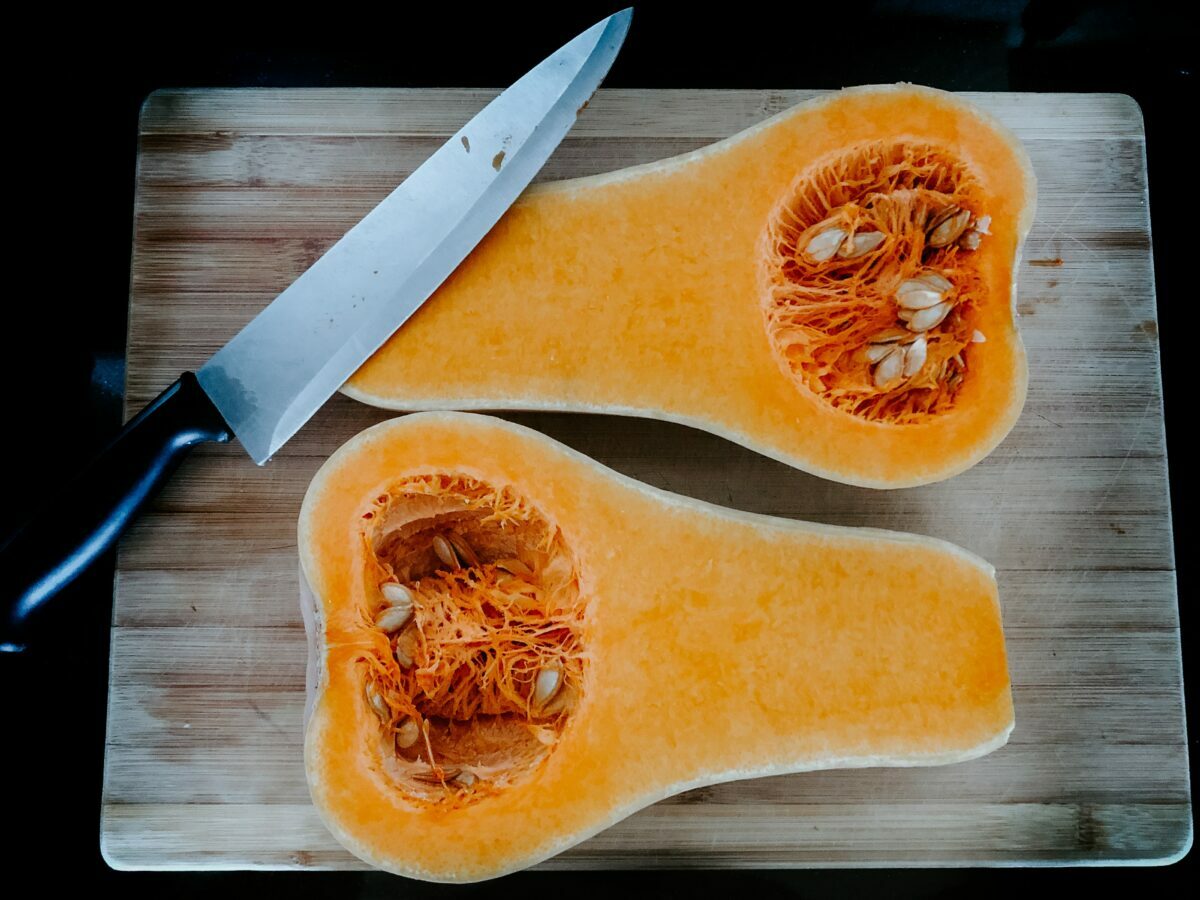
INGREDIENTS
PROCEDURE
- 1 small butternut squash (slice 12 ¼”-disks, then peel and cube the remainder to make 2 cups)
- 1 cup farro
- 1 cup onion, roughly chopped
- 2 cloves garlic, roughly chopped
- 2 sprigs thyme
- 2 sprigs sage
- 1/3 cup olive oil
- 1/4 cup white wine
- 3 cups vegetable stock, warmed to a simmer
- ¼ tsp saffron (optional)
- 1 cup radicchio, halved and thinly sliced
- 1/3 cup parmesan, grated
- ½ cup pumpkin seeds
- Salt and pepper
- Pre-heat oven to 350.
- Line sheet tray with parchment or aluminum foil. Place sliced squash on sheet tray and toss in just enough olive oil to coat. Season with salt and pepper, sprigs of fresh thyme and sage. Bake until squash is cooked through and slightly caramelized around the edges. Remove from oven and set aside.
- Line a separate sheet tray with parchment or aluminum foil. Place pumpkin seeds on tray and toss in 1 tbs. olive oil, allspice and salt and pepper to taste. Bake approximately 10 minutes, or until crisp and very lightly browned. Remove and set aside.
- Add 3 tbs. olive oil to a large heavy bottomed saucepan over medium heat. Add onion, cubed squash and garlic and cook stirring until onion is translucent and squash is quite soft. Take your time with this step, as cooking the squash thoroughly will enable it to melt into the farroto. Add farro and cook stirring until farro is very lightly toasted. Add white wine and cook stirring until wine is mostly evaporated.
- Add 1 cup warm vegetable stock and cook stirring occasionally over low flame. If you choose to include saffron, incorporate it at this point. Continue to add vegetable stock, a little at a time, cooking the farro until al dente and the stock is absorbed. Amount of stock needed may vary with the pot you use and the strength of the flame. Once farro is cooked through, fold in finely sliced radicchio and cook just until wilted.
- Turn off flame and fold in grated parmesan. It is best not to cook farro further once parmesan has been added. Season with salt and pepper to taste. Transfer to warm serving plates or platter and garnish with slices of roasted butternut squash. Sprinkle toasted pumpkin seeds over the top and serve.
More Recipes
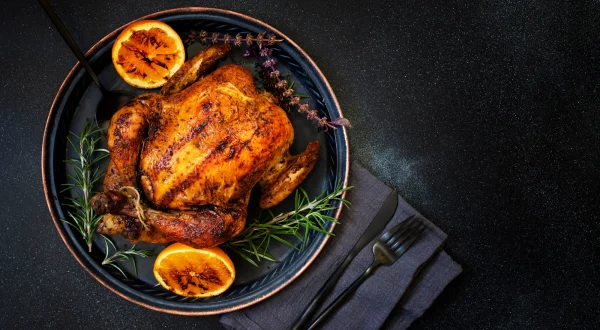
A Chef’s Thanksgiving: Cooking Low and Slow — With a One-Year-Old Sous-Chef
Jump to Recipe About Chefs’ Choir® A chorus of culinary voices from Great Performances—our chefs step out of the kitchen to share recipes, stories, and

November 2025 Food Festival: Cranberries
This month’s Food Festival celebrates cranberries with a chef-crafted cranberry sauce recipe, pro tips, and serving suggestions for your holiday table.
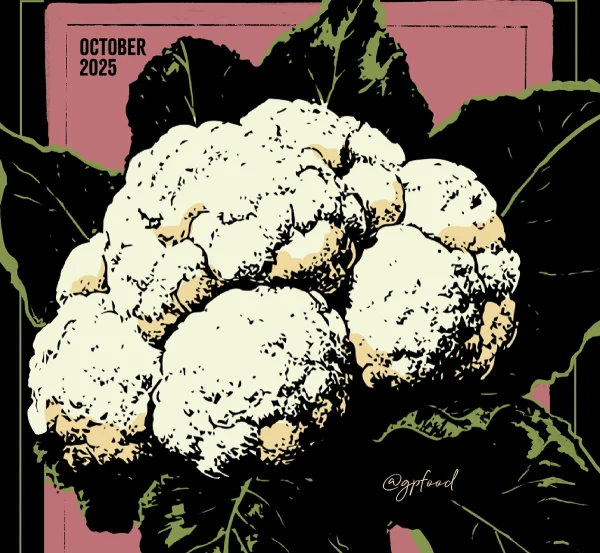
October 2025 Food Festival: Cauliflower
Cauliflower shines in this comforting October recipe. Our chef’s cauliflower ragu is gently simmered with onion, rosemary, and butter until it melts into a savory sauce that’s perfect for pasta night.

A Sweet Tradition for Rosh HaShana: Barbara Glassman’s Honey Cake
As we prepare to welcome Rosh HaShana, we celebrate with foods that symbolize sweetness, abundance, and new beginnings. Apples dipped in honey remind us of

September 2025 Food Festival: Corn
Corn takes center stage this September! Learn how to make a rich and comforting corn chowder featuring sweet kernels, hearty potatoes, and fragrant tarragon—all simmered in a homemade corn stock that makes the flavors shine.

Plantain & Mullein Green Fritters
Crispy, savory fritters made with plantain and mullein leaves. A Chefs’ Choir(SM) recipe that transforms overlooked weeds into a sustainable, crave-worthy dish, perfect with lemon or a yogurt dip.
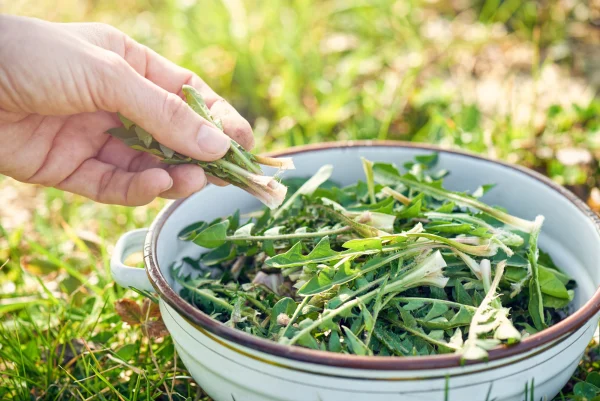
Dandelion Salad Recipe with Dayflowers
A fresh dandelion salad recipe featuring Asiatic dayflowers, toasted walnuts, and honey-mustard vinaigrette. Inspired by the wild plants growing in our garden, this dish turns overlooked “weeds” into a vibrant springtime meal.

Chefs’ Choir: Easy Picnic Recipes and Potluck Dishes That Travel Well
From savory eggplant cake to refreshing summer salads and a nostalgic beet vinaigret, these easy, make-ahead dishes are perfect for your next picnic or potluck.








